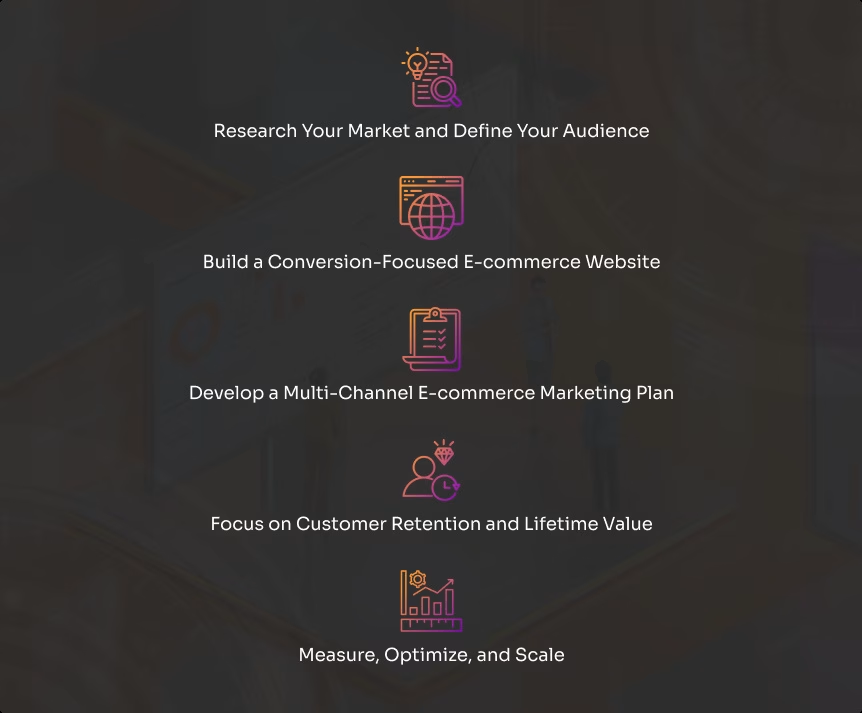
The e-commerce landscape has never been more crowded or more full of opportunity. With over 26 million online stores competing globally, standing out now requires more than great products.
Guesswork doesn’t work anymore. Today’s shoppers are sharper, algorithms smarter, and expectations higher than ever. The brands that will win in 2026 are those that plan intelligently, act decisively, and treat e-commerce marketing as a discipline, not a guessing game.
The difference between selling online and building a brand online is the difference between a transaction and a relationship. The first gets you short-term revenue. The second builds a business that lasts.
In this guide, we’ll break down how to create a winning e-commerce marketing strategy, covering everything from research and conversion-focused design to omnichannel execution, retention, and scaling. These are the rules of e-commerce growth for business owners who’ve been in the game long enough to know that tactics alone don’t win markets – strategy does.
The Foundations of an E-commerce Marketing Strategy

Before talking about SEO, ads, or content, let’s clear one thing up: an e-commerce marketing strategy is not just about running campaigns. It’s the blueprint that defines how your store attracts, converts, and retains customers.
Think of it as your digital business plan – one that unites visibility, experience, and loyalty into a single ecosystem.
The Three Pillars: Visibility, Conversion, and Retention
1. Visibility
How your target audience finds you. This includes SEO, ads, social media, and every channel that drives discovery.
2. Conversion
What happens once they arrive. From UX design to copywriting, your website experience should guide users smoothly toward making a purchase.
3. Retention
What keeps them coming back. Email flows, loyalty programs, and post-purchase engagement turn one-time buyers into lifelong customers.
Each pillar depends on the others. Visibility without conversion is wasted traffic; conversion without retention is wasted potential.
Common Mistakes E-commerce Brands Make
Most struggling online stores fail not because their product is bad, but because their marketing lacks structure. Here’s what typically goes wrong:
- They try to “do everything” at once without understanding what actually drives ROI.
- They copy competitors instead of identifying what makes their offer unique.
- They focus on short-term ads rather than building sustainable visibility through SEO and content.
Why Strategy Must Precede Tactics
In e-commerce, creativity matters, but data comes first. A well-built e-commerce marketing strategy uses data as its compass. Every decision, from ad budgets to email flows, must connect back to measurable business goals. Without that understanding, even the most creative campaign will miss the mark.
Your analytics should reveal the following:
- Who’s buying and who’s not
- Where traffic comes from
- What converts best and what doesn’t.
Five Steps Every Successful E-commerce Brand Follows
Every successful e-commerce brand has one thing in common: structure. Growth doesn’t happen by accident – it comes from following a clear, measurable process that connects strategy, design, and performance.
These five steps outline the path every serious online store should take to grow with purpose and stay profitable while doing it:

Simple, strategic, and built to last – just the way e-commerce growth should be.
Step 1: Research Your Market and Define Your Audience

Effective e-commerce marketing starts with understanding your market better than anyone else.
Conduct Market Research Like a Pro
Use tools like Google Trends, Semrush, and Ahrefs to uncover:
- What your audience is searching for
- How demand changes seasonally
- Which competitors dominate organic visibility.
Pair that data with real-world insights, such as industry forums, social comments, and customer reviews, to understand not just what people buy, but why they buy.
Identify Buyer Personas
A buyer persona isn’t a demographic – it’s a decision map.
Go beyond age or location. Define:
- Pain points and motivations
- Purchase behavior and values
- What makes them hesitate before buying.
Once you know this, you can tailor messaging, design, and offers to match real human behavior instead of assumptions.
Analyze Competitors Strategically
Your competitors are your best teachers, but only if you know how to study them.
Look beyond pricing. Ask yourself:
- How do they position themselves?
- What story do they tell through branding?
- What does their checkout flow look like?
Don’t copy; instead, look for the gaps they’ve missed and learn how to fill them with a better experience or clearer value.
Define Your Niche and Value Proposition
In a sea of e-commerce sameness, differentiation is survival. Your message should tell visitors, within seconds, what makes your brand the obvious choice.
Your value proposition should answer one clear question: “Why should someone buy from you instead of anyone else?” As marketer Seth Godin once put it, “The reason it seems that price is all your customers care about is that you haven’t given them anything else to care about.”
It’s not enough to say “high quality” or “great service” – every brand says that. Be specific. Maybe your edge lies in ethical sourcing, local craftsmanship, or a guaranteed 24-hour delivery window.
Step 2: Build a Conversion-Focused E-commerce Website

Your website isn’t just a catalog – it’s the centerpiece of your online revenue. Every second counts, and every click can mean a lost or won customer. A high-performing e-commerce website is built on one direct goal: turning visitors into buyers.
Yet many businesses still treat their website like a catalog rather than a conversion tool. The difference between the two comes down to structure, psychology, and execution.
Why Design, UX, and Speed Define Your Revenue
Web design isn’t just aesthetics – it’s communication. Good design leads the eye, simplifies decisions, and creates trust before a single word is read. Research from Google indicates that 53% of users leave a site that takes more than 3 seconds to load, and over 70% of online shoppers say site speed affects their willingness to buy.
A conversion-focused site must be fast, intuitive, and responsive. Visitors shouldn’t have to think twice about where to click or how to buy.
UX (user experience) plays an equally crucial role. Navigation should be frictionless, checkout seamless, and calls to action (CTAs) visible. The best e-commerce websites make purchase decisions feel natural, like the next logical step.
The Anatomy of a High-Converting Product Page
Every element on a product page should guide users closer to purchase. Strong visuals are essential: multiple angles, zoom options, and lifestyle photos outperform static images.
Product descriptions should inform, not overwhelm. Think benefits before features: how does this product make life better? Show delivery dates, returns policy, and total cost early. Offer guest checkout and express payments to reduce friction.
Include social proof like customer reviews, ratings, and testimonials. According to Spiegel Research Center, displaying reviews can increase conversion rates by up to 270%. Transparency builds confidence, and confidence converts.
Additional conversion boosters include:
- Clear pricing and shipping information upfront
- Prominent but simple CTAs (“Add to Cart,” “Buy Now”)
- Trust signals, like payment badges and return guarantees
- Cross-sell and upsell sections that feel helpful, not pushy.
Mobile-First and Accessibility by Design
According to OuterBox, a majority of e-commerce traffic now originates on mobile devices. If your store isn’t designed for small screens first, you’re losing revenue. Mobile-first design means faster load times, simplified navigation, and thumb-friendly interfaces.
Accessibility matters, too. A truly modern e-commerce site ensures that everyone can browse, read, and buy, regardless of device or ability. Follow WCAG 2.2 basics: alt text, focus states, readable contrast, and keyboard navigation to broaden reach and improve UX signals. Inclusive design isn’t just ethical; it widens your audience and enhances SEO by improving usability signals.
Partnering with Experts in E-Commerce Development
Building a conversion-optimized store takes more than templates and plugins; it demands technical precision and marketing insight. This is where e-commerce web development becomes the foundation of long-term success.
Professional e-commerce development aligns design, performance, and business goals into a single, cohesive system. Ginger IT Solutions builds scalable, high-performance e-commerce platforms engineered for measurable growth. Their approach centers on tailored development – from custom WooCommerce builds to fully bespoke solutions – backed by clean code, GA4 and server-side tagging, SEO-friendly architecture, and strict performance budgets.
The result is an online store that converts, adapts, and grows with your brand while delivering faster load times, higher conversion rates, and stronger customer lifetime value.
Using Analytics and Heatmaps to Understand User Behavior
What you think users do on your site and what they actually do are rarely the same thing. Tools like Hotjar, Microsoft Clarity, or Google Analytics 4 reveal how visitors interact with your pages: where they scroll, click, and drop off.
This insight is gold. It tells you where friction occurs, which products get the most attention, and how users move through your conversion funnel. Use that data to refine UX design, adjust messaging, and continuously improve performance. A data-driven website is never “done.” It evolves with your audience.
Step 3: Develop a Multi-Channel E-commerce Marketing Plan

Your website may be the core of your e-commerce business, but marketing gives your e-commerce operation momentum and visibility. But here’s the catch: no single channel can drive sustainable e-commerce growth on its own. That is why the most successful brands don’t rely on one platform – they build multi-channel e-commerce marketing strategies that connect SEO, paid ads, content, email, and social media into one system.
Omnichannel doesn’t mean being everywhere. It means being where your audience actually spends time and showing up with the right message at the right moment.
1. SEO: The Long Game That Always Pays Off
SEO (Search Engine Optimization) is still the foundation of e-commerce marketing and arguably its most cost-effective channel over time. The goal isn’t just ranking higher but appearing in front of people who are already searching with intent.
SEO takes time to mature, but once it does, its impact compounds long after the ads stop running.
Keyword Research for E-commerce
Focus on transactional keywords for your product and category pages, such as “buy organic coffee beans online,” while also targeting informational terms through your blog, for example, “how to brew espresso at home.” Tools like Ahrefs or Semrush can help identify which keywords attract qualified traffic, allowing you to prioritize the ones that truly convert.
On-page Optimization
Every product and category page needs optimized meta titles, meta descriptions, headers, and schema markup. Structured data, like Product, Review, and Breadcrumb schema, improves visibility in search results and boosts CTR (click through rate).
Site speed, clean URLs, and logical internal linking directly affect rankings. A slow or poorly structured site not only hurts SEO but kills conversions. Regular technical audits help identify crawl errors, broken links, and indexation issues early – ensuring your store remains fully optimized and search engines can access every key page efficiently.
Content and Link Building
E-commerce SEO thrives on authority. Create high-value MOFU (middle-of-the-funnel) content: detailed guides, product comparisons, and case studies, that attracts backlinks naturally. Strengthen this with guest post collaborations, strategic partnerships, and digital PR to broaden reach and credibility.
2. Pay-Per-Click (PPC) and Paid Social Advertising
Paid campaigns get you in front of the right people fast, but without a clear strategy, they can also burn through budgets fast. They’re most effective when treated as one part of the funnel, not the entire funnel.
Balancing Platforms
Diversify across Google Ads, Meta Ads, and TikTok based on where your audience spends the most time. Google is ideal for capturing high-intent shoppers, while TikTok and Instagram shine at brand discovery and impulse-driven purchases.
For example, one of our clients, Astarta Parfums, achieved remarkable results through Instagram ads, leveraging their strong presence as industry influencers. That success was further amplified by Google Ads campaigns run by Ginger IT and collaborations with local micro-influencers, creating a full-funnel strategy that turned visibility into consistent sales.
Ad Creatives That Convert
Visual storytelling matters. Use product demos, customer testimonials, or “unboxing” videos to capture attention. Each ad should lead to a relevant landing page, never just your homepage. Test multiple creative formats: static, video, carousel, to see which drives the strongest engagement and conversion rates for your audience.
Retargeting Strategies
Up to 70% of online shoppers abandon carts. Retargeting via ads or emails brings them back when interest is highest. Use dynamic product ads to remind them what they’re missing. Adding limited-time offers or personalized recommendations can further increase recovery rates and encourage faster return visits.
3. Content Marketing for E-commerce: The Silent Sales Engine
Content marketing for online stores is no longer a “nice to have” – it’s the engine that drives discovery, builds trust, and strengthens every other marketing channel. It keeps your brand visible even when ads go quiet, bridging the gap between awareness and loyalty.
The most successful e-commerce brands don’t just sell products – they tell compelling stories around them.
Drive Organic Traffic and SEO
Regular blog content targeting long-tail keywords improves visibility and positions your store as a reliable resource, not just a shop. Consistently publishing valuable articles also helps search engines recognize your authority within your niche, making it easier for potential customers to find you organically.
Educational vs. Transactional Content
Balance between educational guides and product-driven pieces. Both inform buyers, but one builds authority while the other drives conversion. For instance, a blog post like “How to Make Espresso at Home” can naturally lead readers to a product page optimized for “Buy Organic Coffee Beans Online.”
The key is to connect educational content with transactional intent – guiding readers smoothly from learning to buying.
Product Storytelling and UGC
Highlight real customers. Feature them in blogs, reviews, and social posts. UGC (User-Generated Content) adds credibility and lowers resistance to purchase, because people trust other people more than ads. Encourage customers to share their experiences with branded hashtags or incentives, turning authentic feedback into a steady stream of fresh, relatable content.
The Role of AI in Scaling Content
AI tools can support keyword clustering, outline generation, and content personalization. But the human touch: insight, tone, and relevance, still makes the difference between content that ranks and content that resonates with your audience.
4. SMS and Email Marketing: The Revenue You Already Own
If social media vanished tomorrow, would your business still stand? It’s a question every e-commerce owner should ask.
Owned channels like email and SMS act as your safety net – assets you control completely. When used well, they turn every interaction into another opportunity to engage, nurture, and sell again.
Automated Flows That Print Money
Set up a welcome series, abandoned cart recovery, and post-purchase follow-ups. These automated flows are responsible for up to 40% of total e-commerce revenue in top-performing stores.
Personalization That Feels Personal
Use purchase history and browsing behavior to recommend products that truly match each customer’s interests. Personalized calls-to-action consistently outperform generic ones because tailored messaging feels more relevant and engaging.
Segmentation for Precision
Not every message suits every customer. Segment your audience by lifecycle stage: first-time buyer, repeat customer, inactive subscriber; and tailor your messaging accordingly. This approach ensures each customer receives content that feels timely and relevant, increasing engagement while reducing unsubscribes and message fatigue.
5. Social Media and Influencer Marketing: Building Real Connections
Social platforms are no longer just digital billboards – they’ve evolved into full-scale marketplaces where customers scroll, shop, and share in the same space. For e-commerce, social media marketing works best when it feels genuine, built on consistency, authenticity, and real connection rather than polished perfection.
Choose Platforms Strategically
According to the HubSpot State of Marketing Report, one of the biggest challenges marketers face is deciding which social media platforms deserve their time and budget. In e-commerce, the best results come from choosing channels that match your audience’s habits: Instagram and TikTok for visual storytelling and trend-driven products, LinkedIn for B2B brands, and Pinterest for design, lifestyle, and inspiration-focused content.
Influencers as Extensions of Your Brand
Micro and nano-influencers often outperform big names when it comes to engagement. Their audiences trust them more, and their rates make sense for small to mid-size brands. The key is alignment – choose creators who genuinely use and believe in your products so their endorsements feel natural, not transactional.
Build Communities, Not Just Campaigns
Community management isn’t vanity work – it’s retention in disguise. Reply to comments, feature customer content, and spark real conversations. Social algorithms reward engagement, but more importantly, so do people. Over time, an active, loyal community becomes one of your strongest marketing assets, fueling word-of-mouth and authentic advocacy that no ad budget can buy.
Step 4: Focus on Customer Retention and Lifetime Value

In e-commerce, growth isn’t defined by how many customers you attract, but by how many you keep. According to HubSpot’s 2024 data, customer acquisition costs (CAC) continue to climb across nearly every industry as competition intensifies, ad prices rise, and consumer attention becomes harder to capture. It now costs significantly more to win a new customer than to retain an existing one, reshaping how smart e-commerce brands approach growth.
Retention has become a cornerstone of long-term strategy. Existing customers aren’t just cheaper to keep – they’re also far more valuable, spending more and converting at a higher rate than first-time buyers. Research from Harvard Business Review shows that improving customer retention by just 5% can increase profits by 25% to 95%.
In a landscape where every click comes at a premium, focusing on customer lifetime value (LTV) brings stability, predictable revenue, and a competitive edge that acquisition alone can’t deliver. Many online stores still treat a single sale as success, but in reality, it’s only the beginning of a long-term relationship.
The Retention Mindset
Customer retention in e-commerce is built on three core ideas: trust, personalization, and value beyond the product. It’s about ensuring your customer’s next purchase feels as good as their first.
1. Build Loyalty Programs That Reward Behavior, Not Just Spending
Traditional points systems are outdated. Today’s customers expect tangible value: early access, exclusive offers, or meaningful perks. Use data to identify your most profitable segments and reward them with real benefits.
2. Leverage Subscriptions and Replenishment Models
For consumable or repeat-purchase products, subscription options simplify the process for customers and stabilize your revenue. Shopify reports that subscription businesses grow revenue 3.7 times faster than traditional e-commerce models.
3. Create a Post-Purchase Experience That Matters
The moment after purchase is when loyalty is won or lost. Personalized thank-you emails, tutorials, and reorder reminders all reinforce connection. Great customer service isn’t reactive – it’s proactive.
4. Encourage Feedback and Use It Wisely
Reviews and surveys aren’t just testimonials – they’re valuable sources of insight. Use them to identify friction points, uncover new product opportunities, and enhance the overall customer experience. Responding publicly to feedback shows transparency and accountability – qualities today’s customers notice and deeply appreciate.
Step 5: Measure, Optimize, and Scale

If you can’t measure it, you can’t improve it; and if you can’t improve it, you can’t scale it. E-commerce marketing isn’t about doing more; it’s about doing what works, better.
Setting the Right KPIs
Every e-commerce business should track metrics that actually reflect growth, not vanity numbers that look good on reports but say little about performance. These are the core signals that show whether your strategy is sustainable.
Here are the essentials:
- CAC (Customer Acquisition Cost): How much you spend to acquire one customer.
- LTV (Lifetime Value): How much a customer is worth over time.
- ROAS (Return on Ad Spend): Are your ads truly profitable?
- AOV (Average Order Value): How much your customers spend per transaction.
- Churn Rate: The percentage of customers who stop buying from you.
A healthy LTV-to-CAC ratio indicates that your marketing generates lasting value rather than one-off sales. Similarly, monitoring AOV trends can reveal upselling opportunities, while tracking ROAS across campaigns helps identify which channels deliver the best ROI.
When analyzed together, these metrics form a roadmap for smarter spending, stronger customer retention, and long-term profitability.
Using Analytics Tools to Stay Smart
With platforms like Google Analytics 4 and tools such as Looker Studio or Supermetrics, you can visualize performance in real time. Combine sales data with behavioral insights to see not only what happened, but why.
Set up dashboards to monitor metrics across channels: SEO traffic, ad conversions, email open rates, and returning customer ratios. Once you have visibility, you can prioritize improvements with confidence.
Continuous Optimization Through Testing
A/B testing isn’t optional – it’s the backbone of modern marketing. Test product images, headlines, CTAs, email subject lines, and ad creatives. Even a 5% lift in conversion rate can translate into huge revenue gains when scaled across an entire catalog.
Optimization isn’t about perfection; it’s about momentum. The fastest-growing e-commerce brands don’t wait for the “perfect” campaign – they iterate relentlessly.
Scaling Sustainably
Scaling isn’t simply spending more on ads. It means your systems: inventory, fulfillment, customer service, and marketing automation; can handle growth without breaking. When you start seeing consistent results, reinvest strategically. Expand high-performing ad sets, localize content for new regions, and double down on retention before chasing expansion.
Wrapping Up
The rules of e-commerce marketing are evolving, but the fundamentals haven’t changed: clarity, consistency, and connection still win. A successful strategy isn’t built on trends – it’s built on understanding your audience, refining their experience, and aligning every effort toward long-term growth.
In a market this competitive, consistency always beats intensity. The brands that endure are the ones that think strategically, act deliberately, and adapt continuously.
If you’re ready to turn your online store into a scalable, data-driven business, begin with an honest audit of your marketing structure. Pinpoint what’s driving results, what’s draining resources, and what needs recalibration.
And when it comes to building or improving your online store, partner with Ginger IT Solutions, an e-commerce development agency that understands how strategy, design, and performance work together. When your website becomes a reflection of strategy rather than improvisation, every pixel serves a purpose and every click moves you closer to growth.
Because in the end, success in e-commerce isn’t just about selling – it’s about evolving.

